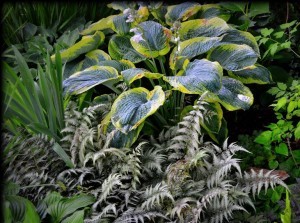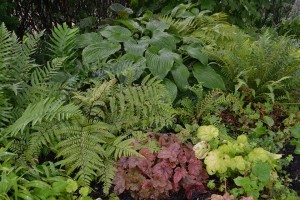Hosta Shade Partners
 Many gardeners are drawn to a particular plant and design gardens to showcase and accentuate that favorite kind. Many gardeners of the shade have hostas on the top of their must-have list. Hostas are easy to grow, come in an ever-increasing variety of shapes and sizes and varying shades of greens, blues and yellows. After a few years there are more hostas to be had from divisions. But we cannot garden with hostas alone—we need a variety of shade plants to create a truly interesting garden. We share some of our favorite companion plants for hostas.
Many gardeners are drawn to a particular plant and design gardens to showcase and accentuate that favorite kind. Many gardeners of the shade have hostas on the top of their must-have list. Hostas are easy to grow, come in an ever-increasing variety of shapes and sizes and varying shades of greens, blues and yellows. After a few years there are more hostas to be had from divisions. But we cannot garden with hostas alone—we need a variety of shade plants to create a truly interesting garden. We share some of our favorite companion plants for hostas.
Coral Bells: Heuchera come in as many varieties as hostas. Foliage ranges from green to purple with deep contrasting venation to orange and yellows. Many of the flowers are tiny, but some varieties have more pronounced flowers atop richly colored stems. Coral Bells are great along the front of the border.
 Common Bleeding Hearts: Is there a more traditional shade flower than Lamprocapnos spectabilis? The gracefully arching stems dripping with heart-shape flowers are a spring-blooming favorite with shade gardeners. The foliage is soft, looks light as a feather and delicate, balancing out the more ridged shape and feel of hosta leaves.
Common Bleeding Hearts: Is there a more traditional shade flower than Lamprocapnos spectabilis? The gracefully arching stems dripping with heart-shape flowers are a spring-blooming favorite with shade gardeners. The foliage is soft, looks light as a feather and delicate, balancing out the more ridged shape and feel of hosta leaves.
Lungwort: Pulmonaria is a fun plant—the foliage has coarse hairs that are scratchy and may irritate the skin, but they also keep foraging deer at bay. The spotted look of the foliage is a nice change of pattern in a garden dominated by hostas. In the spring, clusters of flowers emerge, ranging from pink to purple. These are hardy plants requiring little care.
 Ferns: From ferns no more than a few inches tall to those with rust and orange fronds that are over a foot in height, ferns are a must-have in the shade garden. The foliage is about as different from hosta foliage as one can get. Some varieties are evergreen—a welcome addition to any shade garden.
Ferns: From ferns no more than a few inches tall to those with rust and orange fronds that are over a foot in height, ferns are a must-have in the shade garden. The foliage is about as different from hosta foliage as one can get. Some varieties are evergreen—a welcome addition to any shade garden.
Siberian Iris: I have three clumps of Siberian Iris in my shade garden. Most sources will say they prefer full sun, but these receive dappled light to partial sun and they are thriving. (When I push the envelope with a plant, I start with one, to see how it will respond before investing in multiples of a plant.) The tall, slender iris foliage offers the perfect contrasting shape to the hosta leaves. The flowers are most welcome in the spring and the seed heads are attractive come fall. (Designing with winter interest in the garden is more than colorful foliage—it can also be seed heads.)